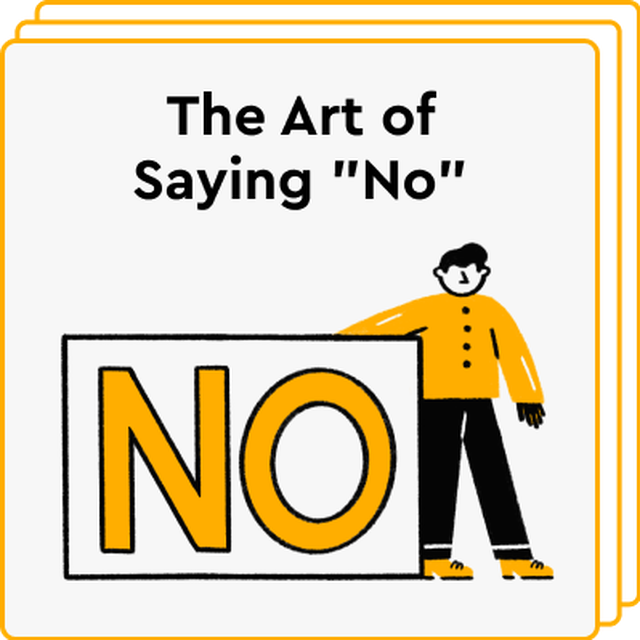Your cart is currently empty!

The Art of Saying No:
•
The Importance of Setting Healthy Boundaries
Many people struggle with the art of saying no, often fearing conflict, guilt, or disappointing others. However, setting healthy boundaries is essential for maintaining mental and emotional well-being. Without clear boundaries, it becomes difficult to manage stress, maintain relationships, and prioritize self-care.
At the same time, learning to say no doesn’t mean being selfish or unkind. Instead, it helps build respect, confidence, and balance in all areas of life. Whether in personal relationships, work, or social commitments, setting healthy boundaries ensures you have the time and energy for what truly matters.
So, how can you master the art of saying no without feeling guilty? Let’s explore the best strategies for establishing and maintaining healthy boundaries in everyday life.
1. Why Saying No Is Essential for Your Well-Being
Saying yes to everything can lead to overcommitment, burnout, and resentment. Because of this, learning to say no is crucial for self-preservation and mental clarity.
The Benefits of Setting Healthy Boundaries:
- Protects mental health by reducing stress and anxiety
- Improves time management by focusing on priorities
- Strengthens relationships by fostering mutual respect
- Boosts self-esteem by reinforcing personal values
- Prevents burnout by ensuring rest and recovery
By recognizing the importance of boundaries, it becomes easier to prioritize self-care and emotional balance.
2. Signs You Need to Set Stronger Boundaries
Sometimes, it’s difficult to recognize when personal boundaries are weak or nonexistent. Because of this, understanding the signs of boundary issues can help determine when it’s time to say no.
Common Signs of Poor Boundaries:
- Feeling constantly overwhelmed or emotionally drained
- Agreeing to things out of guilt or obligation
- Neglecting self-care and personal needs to please others
- Experiencing resentment or frustration after saying yes
- Having difficulty expressing personal limits
If these situations sound familiar, then setting healthy boundaries is essential for improving mental and emotional well-being.
3. How to Say No Without Feeling Guilty
Saying no can feel uncomfortable, especially if you are used to putting others first. However, there are effective ways to set boundaries while maintaining relationships.
Steps to Say No Confidently:
- Be direct and clear – Avoid vague or apologetic responses.
- Use “I” statements – Express personal needs without blaming others.
- Offer an alternative – If possible, suggest another way to help.
- Practice self-affirmation – Remind yourself that saying no is okay.
- Stay firm – Don’t let guilt or pressure change your decision.
Because saying no is a skill, practicing it regularly makes it easier to maintain healthy boundaries.
4. Setting Boundaries at Work and in Relationships
Boundaries are essential in both personal and professional relationships. Without them, work-life balance and emotional well-being can suffer.
How to Set Boundaries at Work:
- Respect your work hours – Avoid checking emails outside of office time.
- Say no to extra tasks – Decline unreasonable workloads politely.
- Communicate limits – Let coworkers and managers know your capacity.
- Take breaks – Step away from work to recharge.
How to Set Boundaries in Relationships:
- Express your needs openly – Be honest about your limits.
- Respect personal space – Allow time for self-care and independence.
- Avoid toxic relationships – Distance yourself from draining people.
- Stand by your decisions – Don’t feel pressured to compromise your values.
By setting healthy boundaries, both professional and personal relationships can become stronger and more fulfilling.
5. Overcoming the Fear of Disappointing Others
One of the biggest challenges of saying no is the fear of hurting or disappointing others. However, it’s important to remember that prioritizing yourself doesn’t mean neglecting others.
Ways to Overcome Guilt When Saying No:
- Acknowledge your limits – You can’t do everything for everyone.
- Realize that no is a complete sentence – No explanation is always needed.
- Understand that true friends respect boundaries – Healthy relationships involve mutual respect.
- Shift your mindset – Saying no allows you to say yes to what truly matters.
Because setting boundaries is about self-respect, prioritizing your needs ultimately leads to healthier interactions and less stress.
6. Practicing Self-Care and Maintaining Boundaries
Once you start saying no and setting boundaries, maintaining them requires ongoing effort. Since personal needs change over time, it’s essential to regularly check in with yourself.
How to Maintain Boundaries Over Time:
- Regularly assess commitments – Only take on what aligns with your goals.
- Reinforce your limits – Remind yourself why boundaries matter.
- Seek support – Surround yourself with people who respect your choices.
- Practice mindfulness – Stay aware of emotional and mental well-being.
By consistently reinforcing boundaries, it becomes easier to protect your time, energy, and mental health.
Final Thoughts: Mastering the Art of Saying No
Learning the art of saying no is a powerful step toward setting healthy boundaries and protecting your emotional well-being. Although it may feel difficult at first, establishing personal limits leads to more balanced relationships, reduced stress, and improved self-care.
Because boundaries create stronger connections and greater self-respect, practicing them regularly helps maintain a fulfilling and stress-free life. Whether in work, friendships, or personal commitments, saying no is an act of self-empowerment and self-care.


Disclosure: This post contains affiliate links. As an Amazon Associate, I earn from qualifying purchases. Read my full disclaimer HERE
